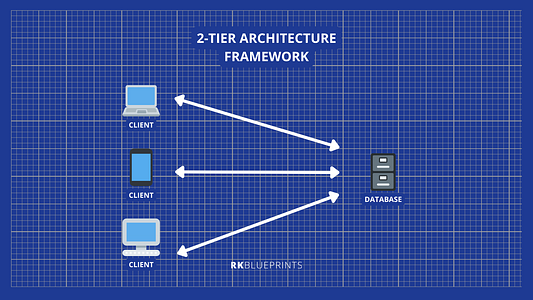The 2-Tier Architecture is one of the simplest and most efficient architectural frameworks for building applications. Whether you’re a beginner learning the ropes of application engineering or web development, or a small business creating a minimal viable product (MVP), understanding this architecture is a crucial first step.
In this guide, we’ll explore what 2-Tier Architecture is, how it works, its advantages, and when it’s best to use it.
What is 2-Tier Architecture?
The 2-Tier Architecture framework organizes an application into two layers or tiers:
- Client Tier: The front-end interface where users interact with the application.
- Database (server) Tier: A single server consolidating the web application logic and the database.
In simpler terms, the client sends requests to the server, which processes the requests, retrieves the necessary data, and sends the results back to the client.
How Does 2-Tier Architecture Work?
Here’s a breakdown of its components and workflow:
- Client Tier: This could be a web browser, a desktop application, or a mobile app. Users interact with the interface to perform actions like submitting a form, viewing a product catalog, or updating a profile.
- Database (server) Tier: The heart of the system. The server handles all business logic (e.g., calculations, rules, validations) and database operations. It stores, retrieves, and updates data as needed, all on the same machine.
For example, imagine a simple e-commerce website:
- The client tier is where users browse products and add items to their cart.
- The database (server) tier processes those cart additions, retrieves product details, calculates totals, and updates the inventory in the database.
Advantages of 2-Tier Architecture
- Simplicity:
2-Tier Architecture is straightforward to design, develop, and deploy. This makes it an excellent choice for beginners or small-scale projects. - Cost-Efficiency:
By consolidating the application logic and database on one server, the need for extensive infrastructure is reduced, lowering costs. - Performance:
Since the application logic and database are on the same machine, data transfer between the two is faster, leading to better performance for small-scale applications. - Ease of Maintenance:
With fewer components to manage, maintaining and updating the application becomes easier and faster.
When to Use 2-Tier Architecture
2-Tier Architecture is best suited for:
- Small-Scale Applications: Like personal websites, internal tools, or small business systems.
- Minimal Viable Products (MVPs): Ideal for testing ideas without heavy investment in infrastructure.
- Educational Projects: A perfect choice for students or developers learning about application development.
However, as applications grow in complexity and user base, the limitations of 2-Tier Architecture — such as scalability and performance bottlenecks — become evident. At that point, transitioning to a more robust framework like 3-Tier Architecture or microservices may be necessary.
Example Tools for 2-Tier Architecture
One excellent tool for building applications using 2-Tier Architecture is Firebase by Google. Firebase simplifies development by offering:
- A Realtime Database for syncing data in real time.
- Built-in Hosting for deploying web apps.
- Easy-to-use Authentication services for managing user sign-ins.
With Firebase, you can build and deploy a functional app without worrying about server management or infrastructure.
How to Get Started with 2-Tier Architecture
Here’s a simple roadmap to help you create your first application using 2-Tier Architecture:
- Plan Your Application: Decide what you want to build (e.g., a personal website, a product catalog, or a blog).
- Choose Your Tools: Tools like Firebase, Node.js, or Python’s Flask framework are great for this architecture.
- Design the Client Interface: Build your front-end using HTML, CSS, and JavaScript or frameworks like React or Vue.js.
- Develop the Server Logic: Write your application logic and set up your database on the server.
- Deploy and Test: Launch your application and test it with real users.
A Blueprint of 2-Tier Architecture
Lets use a sleek blueprint diagram framework to visually showcase the following elements:
- Client Tier (Web Browser/Mobile App): Represents the user-facing side.
- Database Tier (Application Server): Combines the application logic and database operations.

Conclusion
The 2-Tier Architecture framework is an excellent foundation for new developers and small-scale projects. Its simplicity, cost-effectiveness, and ease of implementation make it a popular choice for those just starting their journey into application development.
Whether you’re building a personal website or testing a new idea, mastering this architecture is your first step toward developing more complex and scalable systems in the future.
So, architects, it’s time to roll up your sleeves and start building!
Check out the RK Blueprints technology series, appArchitect: Crafting Blueprints for Implementation, to learn even more — don’t miss out.







Recent Comments